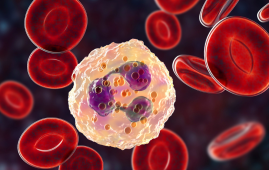

Nanotechnology, according to researchers, can improve the efficacy of cancer treatment. The new study could be beneficial to those who acquire peritoneal cancer in the future.
“This patient group needs more effective treatment methods,” says Astrid Hyldbakk, who recently completed her doctorate at NTNU’s Department of Physics. She is now employed as a researcher for SINTEF Industry in Biotechnology and Nanomedicine.
Cancer of the stomach and intestines frequently spreads to the peritoneum. Because peritoneal cancer is difficult to diagnose, it frequently develops before therapy begins. Unfortunately, therapy procedures are frequently ineffective.
“Late diagnoses and ineffective treatment mean that patients with peritoneal cancer do not have a good prognosis,” says Hyldbakk.
Too little time spent in the peritoneal cavity with chemotherapy medications
Today, surgery is the most common peritoneal cancer treatment, followed by chemotherapy to eliminate any cancer cells that remain following surgery.
“But the chemotherapy drugs don’t stay in the abdominal cavity for long enough to work properly,” says Hyldbakk.
In addition, the chemo drugs can spread to healthy parts of the body, where they cause damage and can result in serious side effects. However, Hyldbakk’s findings gives promise for better treatment.
“Encapsulating the medicine in tiny nanoparticles enables us to keep the medicine in the cavity longer. We can also specially design these nanoparticles so that they deliver the drugs primarily to the cancer cells rather than to healthy cells,” says Hyldbakk.
As part of her dissertation research, Hyldbakk investigated this strategy. She collaborated with researchers from NTNU, SINTEF, and Oslo University Hospital Radium Hospital. The findings were published in Nanomedicine: Nanotechnology, Biology, and Medicine.
“We encapsulated the cytotoxic agent in nanoparticles. These are approximately 100 nanometers in diameter, or one ten-thousandth of a millimeter. We injected these into the peritoneum of mice and rats,” says Hyldbakk.
In other words, this medicine is not yet ready for human usage. However, Hyldbakk’s findings are encouraging.
Releases medicine from tumors
“The drug particles remain in the peritoneal cavity longer and bind specifically to the tumors, where they open and release the cytotoxic agent directly to the cancer cells. A larger amount of the medicine reaches these cancer cells instead of the healthy tissue, thereby increasing the efficacy of the drug and reducing the side effects,” says Hyldbakk.
The study teams feel that employing nanoparticles to deliver chemotherapy is a highly promising new technique for treating persons with peritoneal cancer. However, more research is required.
Now we have to thoroughly characterize and test this method to ensure that the treatment is both safe and effective. This is an important step before we can use the technology on humans,” says Hyldbakk.
SINTEF researchers founded the business NaDeNo last year. In conjunction with SINTEF and the Norwegian Radium Hospital, this business will lead future work. The goal is that they will be able to make this technology available to patients in the near future.
more recommended stories
 Phage Therapy Study Reveals RNA-Based Infection Control
Phage Therapy Study Reveals RNA-Based Infection ControlKey Takeaways (Quick Summary) Researchers uncovered.
 Pelvic Floor Disorders: Treatable Yet Often Ignored
Pelvic Floor Disorders: Treatable Yet Often IgnoredKey Takeaways (Quick Summary) Pelvic floor.
 Urine-Based microRNA Aging Clock Predicts Biological Age
Urine-Based microRNA Aging Clock Predicts Biological AgeKey Takeaways (Quick Summary) Researchers developed.
 Circadian Control of Neutrophils in Myocardial Infarction
Circadian Control of Neutrophils in Myocardial InfarctionKey Takeaways for HCPs Neutrophil activity.
 E-Cigarette Use and Heart Attack Risk in Former Smokers
E-Cigarette Use and Heart Attack Risk in Former SmokersKey Takeaways for Clinicians and Nurses.
 36-Week Pre-eclampsia Screening May Reduce Term Risk
36-Week Pre-eclampsia Screening May Reduce Term RiskA New Preventive Strategy for Term.
 Cardiovascular Risk and Sudden Cardiac Death in Diabetes
Cardiovascular Risk and Sudden Cardiac Death in DiabetesRising Sudden Cardiac Death (SCD) Risk.
 Poor Kidney Function and Alzheimer’s Biomarkers Explained
Poor Kidney Function and Alzheimer’s Biomarkers ExplainedPoor kidney function may influence levels.
 Walking Speed Before Hip Replacement Predicts Recovery
Walking Speed Before Hip Replacement Predicts RecoveryNew Evidence Points to a Simple,.
 Neuroblastoma Drug Combo Extends Survival in Models
Neuroblastoma Drug Combo Extends Survival in ModelsA Promising Shift in High-Risk Neuroblastoma.

Leave a Comment